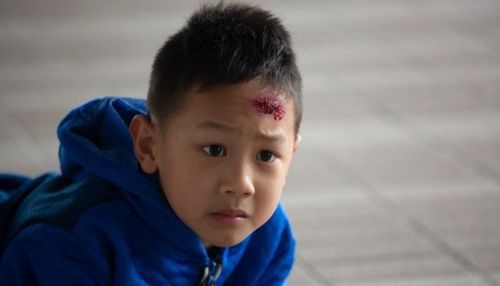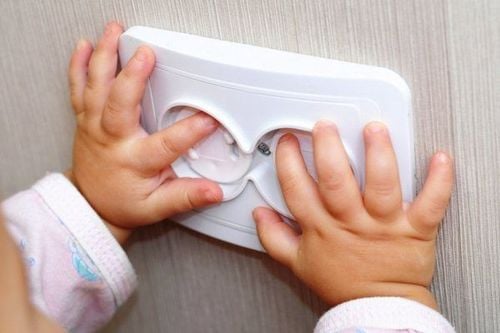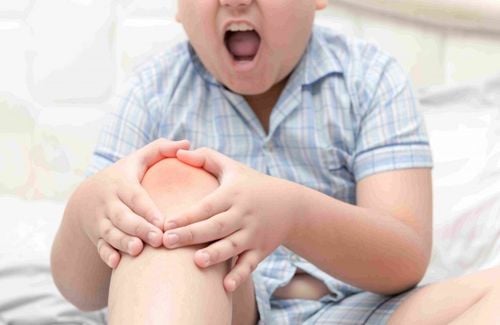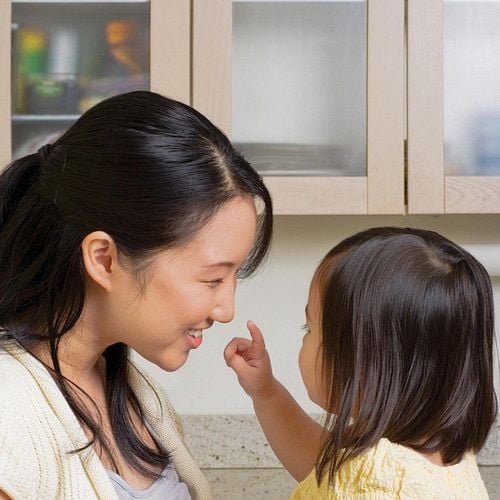This is an automatically translated article.
Unintentional injury is one of the leading causes of death for children in the United States, for example falling at home. Taking precautions can eliminate almost all of these injuries. Appropriate safety measures and child protection steps should be used to keep your family safe at home.1. Danger comes from your own home
Parents worry about how to protect their children from abduction and abuse, yet many overlook one of the biggest threats to safety and well-being. of their children is the house in which they live. Experts say that children between the ages of 1 and 4 are more likely to die from fire, burns, drowning, suffocation, poisoning or falls than from abuse by strangers.According to the US Centers for Disease Control and Prevention (U.S. CDC) approximately 2.3 million children are accidentally injured each year and more than 2,500 children die. That's why it's important to make sure your home is kid-safe.

Thương tích không chủ ý là một trong những nguyên nhân hàng đầu khiến trẻ em ở Hoa Kỳ tử vong, ví dụ trẻ bị ngã tại nhà
2. Some measures to keep children safe at home
Gadgets You will find all sorts of gadgets for sale that can really help in your home care efforts. Or (if you can afford it), hire someone who specializes in child safety equipment to select and install safety devices for you.Remember that devices are no substitute for your eyes and ears. Experts say the best device is still to supervise children.
Expand your child's play area The most effective way to ensure your baby's safety is to keep an eye on your baby's entire house.
Consider issues such as: What is within reach of the child? What looks attractive young? Where will your baby go if he or she can crawl, toddle or walk
Thinking about these things will help you find cupboards, drawers, and other spaces your child can get into. As your child begins to walk and climb stairs, you will have to re-evaluate, each time you think, you will need to consider everything around you more.
Carefully lock or store any potential poisons or other hazards, including cleaning products, medications, vitamins, and knives. Use fences to limit your child's access to areas of the home where dangerous items may be contained.
Watch out for small objects that can be choked or overheard. Pick up any coins, marbles, beads, paper clips, and other small objects you find on a low table or floor or in a drawer or low cabinet.
Be careful when there are guests visiting the house. No matter how carefully you protect your home, others probably haven't applied your standards to their bags. For example, drugs such as aspirin, lipstick and other items that people often carry around are very dangerous for young children.
Protect the power outlet It is recommended to protect the power outlet with a socket cover. Unfortunately, small removable plugs can easily fall into your baby's mouth. If you are using extension cords in your home, cover exposed outlets with electrical tape.
You will have to reassess these precautions as your child grows. Child protection is an ongoing process. If you put the gate at the top of the stairs for a 1-year-old child, by the time your child is 2 years old, hyperactive or naughty children will easily climb through this gate to climb the stairs.

Bạn nên bảo vệ ổ cắm điện bằng nắp đậy ổ cắm
Bookcases, wardrobes and large or heavy equipment are real hazards. Fasten anything you can to the wall. Push items like televisions away from the edge of furniture or move them out of reach of children, and then secure them as well. Always place heavier items on the bottom shelves and in the lower drawers to make them less heavy.
Newborns start pulling things on top of things as soon as they start crawling. And when they learn to climb, watch out! Some kids can climb onto bookcases and whatever else they can get their hands on.
Close the drawers of the wardrobe when you are not using it, otherwise the drawers will create ladders for the child to climb. And especially pay attention to close all drawers of the file cabinet, because pulling out one drawer can cause the cabinet to topple over.
Furniture corners are another common hazard. Cover all sharp corners and oven edges with bumpers to lessen the impact if your child gets hit in these corners.
Install a safety gate Most parents view a safety gate as an essential child protection tool. They allow you to open outside doors for air while keeping your child indoors, help keep them in a designated room or area, and they block children's access to dangerous stairs and forbidden rooms (such as bathrooms or kitchens).
Unfortunately, if the fence is too old or used improperly, the safety gate itself can be dangerous for children. In general, look for gates that your child can't climb out but that you can easily open and close.
Never use pressure gates at the top of stairs. Install a bolted port to the wall instead, it's much more secure.
It's best to purchase brand new safety gates, making sure they are all certified safe for children.
Inspect curtain and curtain ties According to the CPSC, cords on window blinds are a frequent cause of strangulation, killing a child between the ages of 7 months and 10 years in the United States every month. Ky.
Window blinds pose a particular hazard because a baby's neck can get caught in the curtain zipper. Children can get entangled in a window rope and strangled within minutes. Use cordless window blinds whenever possible, and avoid placing your baby's crib near windows.
If you have curtains with a zipper in your home, cut the zipper or use a cord shortener to keep it out of reach. You can also replace a loop with a safety tassel.

Theo CPSC, những sợi dây trên tấm rèm cửa sổ là nguyên nhân thường xuyên khiến trẻ em bị siết cổ
Always open sliding, vertical, or locked windows to prevent children from opening them.
Low windows should not open more than 4 inches. There are window stops that can prevent the window from opening more than this. Some newer windows come with window breakpoints already installed.
Window screens are not strong enough to prevent falling. For safety, install window rails or window guards, which bolt to the edge of the window frame, have slats spaced no more than 4 inches apart, and can be adjusted to fit doors. windows come in different sizes.
Keep furniture away from windows to prevent children from climbing on and touching windows.
Use door guards or door handles on doors and door hinges to avoid injury to hands. Children are more likely to get their fingers and hands stuck or crushed when the door is closed.
Prevent Poisoning According to the American Association of Poison Control Centers, more than 1.2 million cases of possible poisoning in children under 5 years of age were reported in 2009. CPSC reports that about 30 children American children die from poisoning every year.
Keep hazardous products out of the reach of children. Place safety locks on all cabinets and drawers containing bug sprays, cleaning products, medications, and other potentially toxic substances.
Throw away old or expired medicine. Most medications should not be flushed down the toilet or down the drain, as they can contaminate the water supply.
Beware of potential poisons. Not all poisons are easy to detect. Carbon monoxide is a colorless and odorless gas produced by malfunctioning fuel-burning equipment such as furnaces, water heaters, ovens, stoves, range hoods, and emergency generators. Although you can't see it, smell it, or taste it, carbon monoxide can be deadly.
To protect your family, install carbon monoxide detectors in every sleeping area in your home, including the nursery. Check your device's battery every spring and fall when you change your watch. If the alarm goes off, leave the house immediately or call the local emergency number.
Breathing lead dust or fumes or swallowing anything with lead in it can give your child lead poisoning, Lead poisoning can cause learning disabilities, kidney disease, brain damage, developmental delays development and other issues. If you have exposed or damaged lead paint in your home, have a professional remove it completely or cover it with a sealant. Until lead can be removed, wash your child's hands and face as well as toys often to reduce their exposure to lead-contaminated dust.
Drowning prevention According to CPSC, more than 430 children under the age of 5 drowned between 2005 and 2009. Drowning accidents are the leading cause of death for children aged 1 to 4 years.

Tai nạn đuối nước là nguyên nhân hàng đầu gây tử vong cho trẻ em từ 1 đến 4 tuổi
Most drowning deaths in the home involve infants in the bathtub. Never leave your baby unattended in the tub alone. Monitor your child whenever he is in the bathroom and install the safety pin on the toilet lid to prevent him from accidentally falling in.
According to CPSC, infants and toddlers can drown in water that is only a few inches tall. If a child loses balance while focusing on the toilet bowl or bucket, he or she can fall over and get stuck.
If you are using a bucket of water for mopping or mopping, empty the water as soon as you finish the job.
Finally, be careful around pools and hot tubs. Swimming pools are a major risk of drowning. More than 200 children in the United States have drowned in children's pools over the past decade.
If you have a pool at home, fence it with a fence at least 4 feet high and lock the gate to the pool after each use. Always hold tight and lock the lid on your hot tub.
Fire Prevention According to the Federal Emergency Management Agency, nearly 2,500 children in the United States were injured or killed in residential fires in 2007, and more than 1,000 of those children were under 4 years old.
Experts say a smoke alarm can halve the risk of dying from a fire. Install smoke alarms in every room of the house. Check these devices monthly to make sure they are working, and change the batteries annually.
Consider installing smoke alarms that use long-life (ten-year) batteries.
Consider placing a fire extinguisher in your home and have it serviced or inspected according to the manufacturer's instructions.

Cân nhắc đặt bình chữa cháy trong nhà và bảo dưỡng hoặc kiểm tra theo hướng dẫn của nhà sản xuất
When a child shows abnormal signs of health, parents can take the child to Vinmec Health system for timely examination and treatment.
In addition to taking care of and protecting children, parents should pay attention to nutrition to improve children's resistance. At the same time, add supporting foods containing lysine, essential micro-minerals and vitamins such as zinc, chromium, selenium, B vitamins,... snacks and less digestive problems.
Parents can learn more:
Why do you need to supplement Lysine for your baby?
The role of zinc - Guidelines for reasonable zinc supplementation
Please visit the website Vinmec.com regularly and update useful information to take care of your baby and family.
Reference source: babycenter.com; webmd.com













